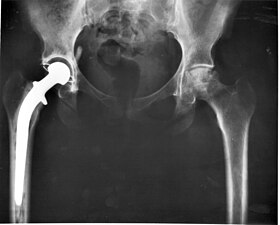Types of Joint Replacement
- Shoulder replacement
- Hip replacement
- Knee replacement
- Ankle replacement
- Finger joint replacement
- Elbow replacement
Risks and Complications
- Medical risks
- Heart attack
- Stroke
- Venous Thromboembolism
- Pneumonia
- Increased confusion
- Urinary Tract Infection (UTI)
- Intra-operative risks
- Mal-positioning of the components
- Shortening
- Instability/dislocation
- Loss of range of motion
- Fracture of the adjacent bone
- Nerve damage
- Damage to blood vessels
- Immediate risks
- Superficial or deep infection
- Dislocation
- Medium-term risks
- Dislocation
- Persistent pain
- Loss of range of motion
- Weakness
- Indolent infection
- Long-term risks
- Loosening of the components
- Polyethylene synovitis - wear of weight-bearing surfaces
- Controversies: best bearing surface, cemented vs uncemented fixation, minimally invasive surgery
Technique
- Pre-anaesthetic work-up required
- Pre-operative planning with accurate X-rays and implant design
- Hospitalization followed by weeks of protected function, healing, and rehabilitation
- Early mobilization to reduce complications
- Physiotherapy for recovery of function
Materials used in joint replacement
- Metals and metal alloys such as cobalt, chrome, titanium, vanadium, stainless steel, aluminum, nickel, hafnium, silicon, cobalt-chrome, tungsten, and zirconium
- Ceramic materials used in knee replacements
- Ceramic components designed to be benign and not sharp if shards break off
Prosthesis replacement and History
- Prostheses may need to be replaced due to complications like infection or prosthetic fracture
- Replacement can be done in one surgical session or in separate surgeries
- Animal testing of artificial joints began in 1939
- Previous forms of arthroplasty included interpositional arthroplasty and excisional arthroplasty
- Most common form of arthroplasty today is the surgical replacement of a joint or joint surface with a prosthesis
Joint replacement is a procedure of orthopedic surgery known also as arthroplasty, in which an arthritic or dysfunctional joint surface is replaced with an orthopedic prosthesis. Joint replacement is considered as a treatment when severe joint pain or dysfunction is not alleviated by less-invasive therapies. Joint replacement surgery is often indicated from various joint diseases, including osteoarthritis and rheumatoid arthritis.[citation needed]
| Joint replacement | |
|---|---|
 | |
| ICD-10-PCS | 0?R?0JZ |
| ICD-9-CM | 81.5, 81.8 |
| MeSH | D019643 |
Joint replacement has become more common, mostly with knee and hip replacements. About 773,000 Americans had a hip or knee replaced in 2009.